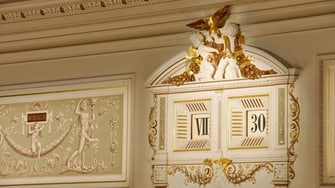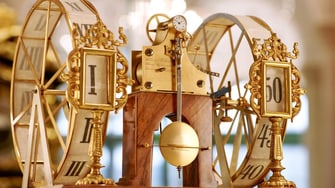
The 5-minute clock of the Semper Opera in Dresden - a masterpiece by A. Lange@Söhne
Share
A mission with consequences
A “respectable chronometer” the likes of which the world had never seen before – that was the brief given to master watchmaker Johann Christian Friedrich Gutkaes when he was asked to build a clock for the new opera house in Dresden at the end of the 1830s.
The clockmaker, who also looked after the objects of the Mathematical-Physical Salon in the Dresden Zwinger, probably developed this clock in his studio just around the corner from the royal palace, where he also trained his future son-in-law Ferdinand Adolph Lange as a clockmaker from 1830 to 1835.
On April 12, 1841, the Dresden Semper Opera House, then still called the Royal Court Theatre, was inaugurated. Its prominent stage clock caused a sensation and was considered a masterpiece of Saxon clockmaking.
New design approaches
The unusual design may have been inspired by 17th-century French clocks that displayed time using two framed dials or wheels.
The digitally displayed stage clock at La Scala in Milan may also have served as a model. Johann Christian Friedrich Gutkaes opted for an innovative approach for his five-minute clock, featuring two fabric-covered cylinders with printed numerals, driven by a gear train behind a frame with two windows.
The clock displayed the hours with Roman numerals from 1 to 12 and the minutes with Arabic numerals from 5 to 55, with the minute display remaining blank on the hour. When we developed the large date display after our refoundation in 1990, we adopted this concept: The left window also remains blank from the first to the ninth day of the month.
Gutkaes developed and built the clock together with his employees, including his business partner and later son-in-law Ferdinand Adolph Lange. Why they implemented the clock with numeral dials is unknown, but the most plausible explanation is that the display had to be legible even in the rear rows of seats.
The rollers, which had a diameter of approximately 160 centimeters, could display numbers approximately 40 centimeters high. The space in the proscenium above the stage was insufficient for a similarly legible, but analogue display.

After the disaster
In 1869, a major fire destroyed the first Dresden Opera House and its famous stage clock. Ludwig Teubner, a student of Gutkaes, was commissioned to create a new clock as part of the reconstruction. The result was a large clock that combined elements of traditional tower clocks with the design principles of classical clockmaking. It was constructed by Teubner's workshop and the Zachariä Tower Clock Factory, which still exists today, according to the latest standards of the time. Ludwig Teubner, his son-in-law Ernst Schmidt, and his grandson Felix Schmidt oversaw this second clock for three generations.
The functional principle of the second five-minute clock is preserved in a 1:10 scale model, built in 1896 by Hugo Leipold and Otto Herrmann, both of Teubner's apprentices. After Herrmann's death, it was passed on to Herrmann, who later emigrated and took it with him to Hawaii. From there, it returned to Teubner's grandson, Felix Schmidt, in 1951. He donated it to the Mathematical-Physical Salon in Dresden in 1980, where it is still on display today.

Harbinger of a new era
The reconstruction of the Semper Opera House, destroyed in World War II, also included the construction of a new five-minute clock. This, the third version of the clock, was created by a team of experts led by engineers Klaus Ferner and Harry Julitz. The reconstruction of the clock also included a careful modernization of the drive technology and took over six years to complete.
Since the ceremonial inauguration of the lavishly restored Semperoper on February 13, 1985, the silently ticking five-minute clock high above the stage has once again delighted visitors from all over the world.
Just a few years later, in the early 1990s, the five-minute clock was honored in a special way when its distinctive time display inspired the outsize date of our LANGE 1. Walter Lange, the great-grandson of Ferdinand Adolph Lange, presented the new timepiece on October 24, 1994, in Dresden's Residenzschloss.
Just as with its larger predecessor, improved legibility was the driving force behind this innovation. The asymmetrically arranged displays, combined with the outsize date, create the very tension that makes the LANGE 1 our most distinctive timepiece.

